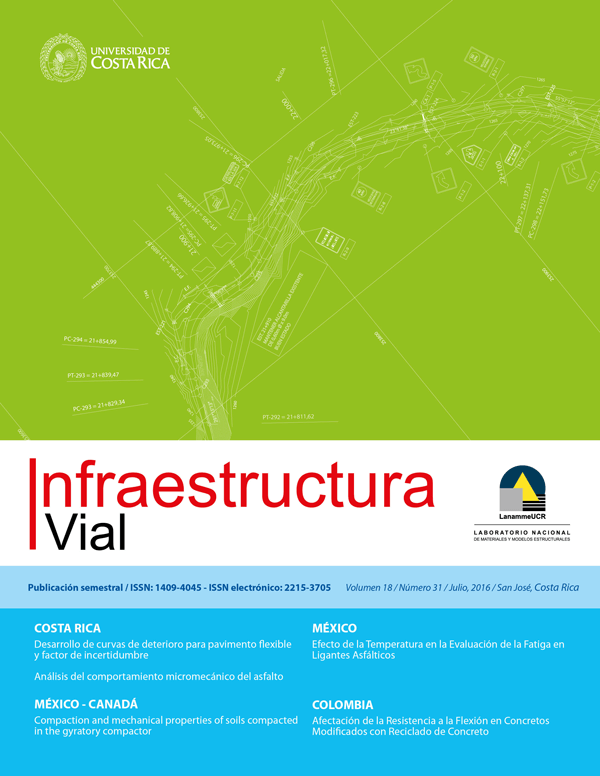Resumen
The authors present a series of compaction curves obtained in fine-grained soilsthrough use of a gyratory compactor. The effect on compaction curves of variables such as vertical pressure, angle of gyration, and speed of gyrationis shown. The curves obtained with the gyratory compactor were compared with those obtained using traditional methods of compaction (Proctor standard and modified compaction). It was observedthat the standard compaction curve can be obtained with 200 gyrations, 1.25 degrees of angle of gyration, and a vertical pressure of 200 kPa.On the other hand, with the combination of variables studied in this research, modified compaction curvescould not be reached. Tests were also performed to measure resilient modulus and unconfined compression strength onspecimens prepared at optimum compaction conditions, 2% below the optimum and 2% above the optimum (for Proctor standard tests) using two methodsof compaction.The results indicate that unconfined compressionstrengths and resilient modulus are related to the compaction method when samples are compacted at water content below optimum.Citas
Browne, M.J. 2006. Feasibility of Using a Gyratory Compactor to Determine Compaction Characteristics of Soil. Thesis of Master of Science in Civil Engineering.Montana State University. November 2006.
Coyle, H.M. and West, E.C. 1956. Laboratory compaction of a silty clay to simulate field density curves. Thesis of Master of Science. Massachusetts Institute of Technology. June 1956.
Holtz, R. 1990. Introduction. State of the art report. Guide to earthwork construction. Transportation Research Board. National Research Council. Washington, D.C.
Holtz, R. 1990. Compaction Concepts. State of the art report. Guide to earthwork construction. Transportation Research Board. National Research Council. Washington, D.C.
Lee, K., Prezzi, M., and Kim, N. 2007. Subgrade Design parameters from samples prepared with different compaction methods. Journal of Transportation Engineering. Vol. 3, No. 2. February 1. pp. 82-89.
Milberger, L.J. and Dunlap, W. A. 1966. A gyratory compactor for molding large diameter triaxial specimens of granular materials. Research Report Number 99-2. Texas Transportation Institute.
Parsons, R.L., Foster, D.H., and Cross, S.A. 2001. Compaction and Settlement of existing embankments. Report No. K-TRAN:KU-00-8. University of Kansas.
Ping, W.V., Leonad, M., and Yang, Z. 2003. Laboratory Simulation of Field Compaction Characteristics (Phase I). Research Report No. FL/DOT/RMC/ BB-890(F). Department of Civil and Environmental Engineering. Florida A&M University. Florida State University. March 2003.
Industrial Process Controls Limited. 1998. PC-Based SERVOPAC Monitor. Reference Manual for Version 1. April, 1998.
NCHRP 1-28a. Harmonized Test Methods for Laboratory Determination of Resilient Modulus for Flexible Pavement Design.


